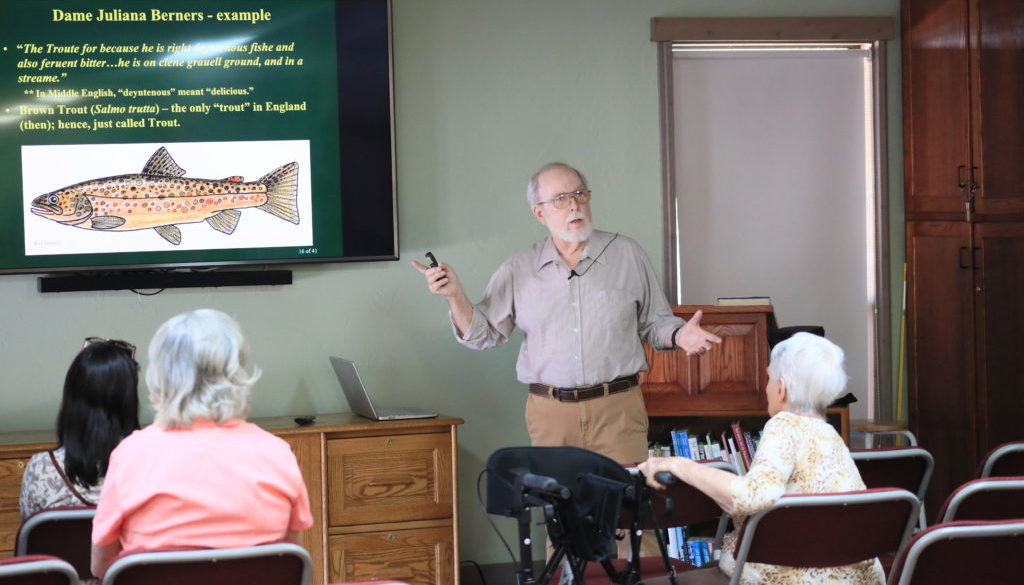In celebration of Women’s History Month, the Riverside Nature Center welcomed biologist Bob Howells to highlight a few of the remarkable women who had a great impact on the study of natural history.
“Some fields like engineering and chemistry are where men tend to dominate, but in some of the biological fields women have been major players,” said Howells.
Science is a heavily gendered profession, with men making up the majority of the STEM workforce to this day. Though often not properly credited or recognized, women have made significant contributions to the study of natural history.
“I say Margaret Mead, Jane Goodall, Dian Fossey, everybody here knows them, but if I ask about Marie Poland Fish or Ethelwynn Trewavas–Blank. No idea!” said Howells.
To show his respect for these pioneers in natural history, Howells highlighted some of the lesser-known women that left a great impact in their respective fields.
“Marie Poland Fish was a marine biologist and oceanographer, known also for her bioacoustic work. She was on the oceanographic expedition that William Beebe ran for the New York Zoological Society and was the first person to identify American Eel eggs. It blew scientists’ minds for years not knowing where freshwater eels spawned, and she was the first to finally find it,” said Howells.
Bioacoustics is the study of how organisms produce, transmit, and receive sounds. Fish’s research in underwater bioacoustics was vital in calming security fears and tensions after World War II.
“During the Cold War, the Swedes were listening on their hydrophones and they were certain that Russian submarines were patrolling through their waters – they were hearing these sounds. They saw what happened in Eastern Europe after the war–are they coming for Sweden?” said Howells.
Fearful of their national security amid Cold War tensions, the Swedish government convened with England for guidance.
“Finally they showed some of the recordings to the British who had a good laugh and said, ‘Those aren’t Russian submarines, they’re farting Atlantic Herring.’ When you frighten a school of Atlantic Herring, they all fart and take off in unison. A bunch of flatulating fish could have caused a war and it was her work that helped sort that out,” said Howells.
Fish spent 22 years leading the Underwater Sound Program for the Department of Naval Research. In 1966, she was awarded the Distinguished Service medal for her work.
Another scientist Howells featured in his Women in Natural History presentation was the aforementioned Ethelwynn Trewavas, known for her studies of Cichlid fish and her long career as a museum curator and scientist.
“She started working for the British Museum of Natural History in 1935 as an assistant curator. She had ultimately spent nearly 50 years there as their senior scientist in the fish section. She’s had at least 21 species named after her. This is phenomenal,” said Howells.
To emphasize how incredible a feat it is in the science community to have a species named after yourself, Howells explained the process of species naming.
“ When you describe a species, you don’t name it for yourself–it’s tacky, you don’t do that. Someone must name it in your honor. There was another fishery biologist from this country who paid for a lot of expeditions to the tropics looking for tropical fish. Every time they found a new one, they named it after him – He only had 16. I’ve only had one named after me, so 21 is pretty phenomenal,” said Howells.
Trewavas’ research, and many of the women covered in his speech, impacted Howells work directly.
“Back in 1923, she wrote the definitive book on Tilapia, and it was a good thing she did because one of the reasons Parks & Wildlife brought me here was the work I did with exotic fish, including things like Tilapia,” said Howells.
Trewavas’ book, titled “Tilapiine fishes of the genera Sarotherodon, Oreochromis, and Danakilia,” was used as evidence in meetings involving legalizing Tilapia in America.
“In the late 1980s, only two species of the Tilapia were legal in Texas. At that time, there were about 98 other species – they were all illegal,” said Howells.
Competitive tournament bass fishing was rising in popularity, which led to disputes over which species of fish should be allowed in Texas ecosystems and farms.
“The bass fishermen came to Parks & Wildlife, let us know they decided that all the Tilapia had to be made illegal. They had a lot of money and a lot of political clout. At the same time, fish farmers were saying, we can raise Tilapia for human consumption. We want even more kinds of Tilapia,” said Howells.
The conflicting demands over tilapia species in Texas challenged Howells and the Parks & Wildlife Department.
“The competition between these two groups got so heated when we had Parks and Wildlife Commission meetings, we had some of our biologists in Austin receive death threats over Tilapia. People came into meetings not only with questions, but with their lawyers or sometimes even their congressmen,” said Howells.
It was Trewavas’ extensive and descriptive book over the different Tilapia species and identifiers that set the framework for how Howells and the Parks & Wildlife Department set regulations.
“Fortunately this book helped because she did so much technically. The lawyers loved it. Boom! Dropped the Tilapia book – dropped the mic. We were able to convince them that you couldn’t just look at a fish and count the fin rays and scales and know what it was. We used her book to show how other ways were not going to work, we’ve got to ID it genetically. Her book was a major guiding device during those days,” said Howells.
Howells entailed the achievements of many other women scientists throughout his presentation, relating how their contributions impacted his work and continues to shape research today.
For more information about the programs offered at the Riverside Nature Center, check out their website at www.riversidenaturecenter.org.
